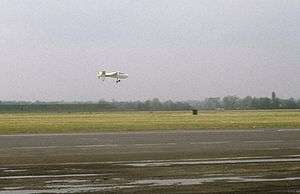Aerocar Mini-IMP
The Aerocar Mini-IMP (Independently Made Plane) is a light aircraft designed by Moulton Taylor and marketed for homebuilding by Aerocar International. It is a scaled-down derivative of his original Aerocar IMP design. A two-seat version called the Bullet was also built. The Mini-IMP follows the same unconventional layout as its larger predecessor, with a center mounted engine, long driveshaft to a tail propeller, and inverted-V rudder/elevators.[1]
| Aerocar Mini Imp | |
|---|---|
 | |
| Mini Imp flyby in 1969 | |
| Role | Homebuilt aircraft |
| National origin | United States |
| Manufacturer | Aerocar International |
| Designer | Moulton Taylor |
| Status | Plans available (2015) |
| Developed from | Aerocar IMP |
The aircraft is available in the form of plans for amateur construction. Following Taylor's death, the plans and licensing for the Mini-IMP have been marketed by the Mini-IMP Aircraft Company of Weatherford, Texas.[2][3][4]
Design and development
The aircraft features a cantilever high-wing, a single-seat enclosed cockpit, fixed or retractable tricycle landing gear or conventional landing gear and a single engine in pusher configuration.[2][3]
The aircraft is made from riveted aluminum sheet. Its 24.5 ft (7.5 m) span wing is mounted well behind the pilot and employs a NASA GA(PC)-1 airfoil. The engine is mounted behind the pilot's seat driving the propeller through an extension shaft. Engines used include the 60 to 100 hp (45 to 75 kW) Volkswagen air-cooled engine four-stroke.[2][3][5]
Taylor claimed the Mini-IMP was not an original design, but an updated version of the 1912 Edison Doladay Bullet, a design that was capable of 110 mph in the earliest days of flight.[6]
In the late 1970s inquiries were made concerning a military version of the Mini-IMP, skinned with Kevlar, armed with two 7.62-millimeter machine guns, and with room in the baggage compartment for a considerable quantity of ammunition. Nothing came of the proposal.[7]
Specifications (typical Mini-IMP)
Data from Bayerl and Tacke[2][3]
General characteristics
- Crew: one
- Wingspan: 24 ft 6 in (7.46 m)
- Empty weight: 518 lb (235 kg)
- Gross weight: 805 lb (365 kg)
- Fuel capacity: 12 U.S. gallons (45 L; 10.0 imp gal)
- Powerplant: 1 × Volkswagen air-cooled engine four cylinder, 1835 cc, air-cooled, four stroke automotive conversion, 60 hp (45 kW)
- Propellers: 2-bladed composite
Performance
- Maximum speed: 175 mph (281 km/h, 152 kn)
- Cruise speed: 150 mph (240 km/h, 130 kn)
- Stall speed: 43 mph (69 km/h, 37 kn)
- Rate of climb: 1,200 ft/min (6 m/s)
References
- "Mini-IMP". Mini-imp.com. Retrieved 2012-10-09.
- Bayerl, Robby; Martin Berkemeier; et al: World Directory of Leisure Aviation 2011–12, page 111. WDLA UK, Lancaster UK, 2011. ISSN 1368-485X
- Tacke, Willi; Marino Boric; et al: World Directory of Light Aviation 2015–16, page 117. Flying Pages Europe SARL, 2015. ISSN 1368-485X
- Vandermeullen, Richard: 2011 Kit Aircraft Buyer's Guide, Kitplanes, Volume 28, Number 12, December 2011, page 61. Belvoir Publications. ISSN 0891-1851
- Lednicer, David (2010). "The Incomplete Guide to Airfoil Usage". Archived from the original on 9 August 2013. Retrieved 3 January 2012.
- "Designers talk about the future". Air Progress: 18. January 1979.
- Jane's Information Group. Jane's All The World's Aircraft, 1981–1982 edition.